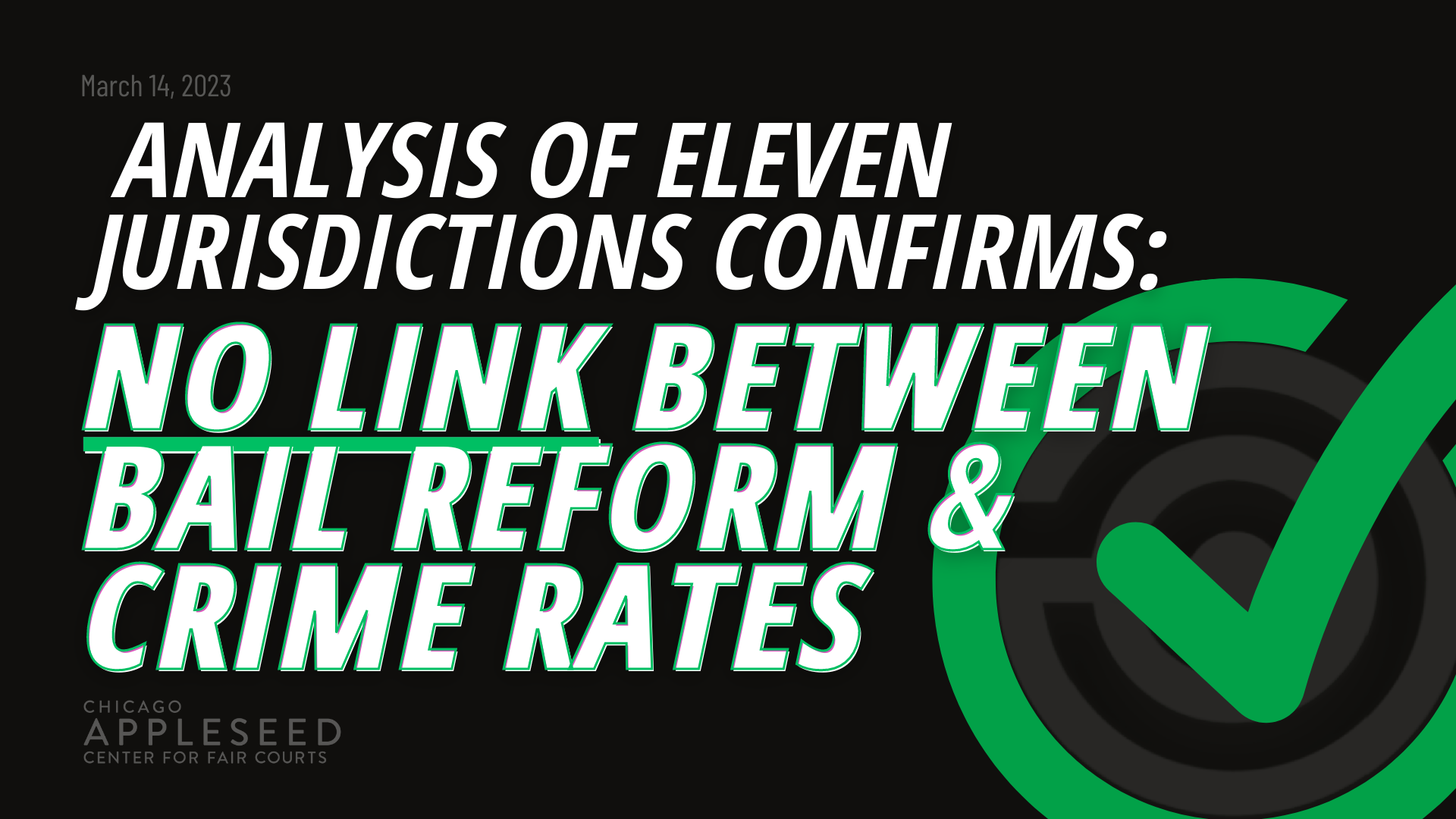Analysis of Eleven Jurisdictions Confirms: Bail Reform Does Not Cause Increased Crime Rates
As the Illinois Supreme Court hears oral arguments on the constitutionality of the Pretrial Fairness Act, it is vital to remember that abolition of money bail – and the decreased jail populations that will follow it – is a safe, just, and effective public policy. A new research report from the Guggenheim Foundation is the latest in a long series of evidence-based studies that confirm that bail reform does not cause an increase in crime and, in fact, strengthens communities.
In January 2023, Don Stemen and David Olson for the Harry Frank Guggenheim Foundation published a report entitled, “Is Bail Reform Causing an Increase in Crime?” This report investigated eleven different jurisdictions that had reformed their bail systems in some way, and ultimately found that these policies had no impact on the levels of violent and nonviolent crime. The report suggests that pretrial reforms such as “reducing pretrial detention and eliminating money considerations” do not negatively impact public safety and, in fact, “improve the [overall] well-being of communities most impacted by crime.” Because the vast majority of people who are held in pretrial detention are there because they are unable to pay, pretrial bail reforms are an important step in dismantling an unfair system that penalizes poor defendants, many of whom are Black and Brown people.
Though critics argue that bail reform makes communities less safe, Stemen and Olson’s analysis of multiple studies shows that there is no evidence supporting that claim. Stemen and Olson note the types and scope of bail reforms that have been implemented in eleven different jurisdictions across the United States. Including, for example:
- In Harris County, Texas, a 2019 judicial rule states that defendants charged with a misdemeanor may not be required to pay more than $100 in bail. As a result, “87% of misdemeanor defendants were released pretrial” compared to 60% before the rule went into effect. Although the percentage of defendants who were charged with a new violent offense within one year of being released slightly increased, the overall percentage of released defendants charged with any new criminal activity decreased from 23% to 21%.
- Legislative bail reforms in New Jersey abolished bail in most cases, causing the number of defendants released pretrial to increase from 94% to 96% and the percentage of released defendants with new criminal activity to increase from 24% to 27%. The additional criminal activity was not considered significant by the authors of the report due to the fact that it still “account[ed] for a very small proportion of all cases filed.”
- In Philadelphia, Pennsylvania, defendants charged with specific misdemeanors and low-level felonies did not have to pay bail. Consequently, the percentage of felony defendants released grew from 24% to 32% while the percentage of misdemeanor defendants grew from 83% to 90%. In this jurisdiction, Stemen and Olson found that the percentages of both felony defendants and misdemeanor defendants who were charged with a new criminal offense within four months of the original charge decreased by 2% and 1%, respectively.
Stemen and Olson also provide details about the effect of pretrial bail reform in Cook County specifically. Bail reform efforts were first effective here in 2017 due to a judicial order that established that judges must “consider a defendant’s ability to pay when setting bail amounts” in addition to “creating a presumption of release without bail for all defendants.” As a result of this judicial order, an increased number and percentage of defendants charged with felonies were released prior to their trials. The percentage of people charged with felonies who were released rose from 77% to 81% while the number rose from 8,700 to 9,200 people. The report finds that the percentage of Cook County defendants who are charged with a new offense within a year of their release was measured at 17% both before and after pretrial bail reforms were implemented. Additionally, defendants who are released while awaiting trial have been found to be very unlikely to commit violent crimes, with this group of people accounting for less than 1% of the county’s arrests for violence. In fact, in the year immediately after the bail reform laws went into effect, Cook County experienced a 12% decrease in violent crime.
Stemen and Olson conclude that pretrial bail reform and crime levels are not linked. They note that this statement should not be surprising as bail reform “does not markedly increase the number or percentage of people released pretrial.” Instead, it simply changes the manner in which they are released, as they no longer have to post bail.
While bail reform has a negligible effect on crime, it has sweeping benefits for defendants and their communities.
In the first six months after pretrial bail reform went into effect, Cook County defendants and their families, who were primarily people of color, saved $31.4 million in avoided bail costs, instead being able to use the money for expenses such as food, healthcare, and housing. Furthermore, defendants who remain in pretrial incarceration due to their inability to afford to post bail are not able to work, putting their income, housing, and custody of children at risk Additionally, these defendants are also more likely to be convicted and sentenced to incarceration than those who are able to post bail. Overall, bail reform has a plethora of benefits that certainly outweigh unfounded concerns about it damaging public safety.
Learn more about the Pretrial Fairness Act here.
Anna Craver (she/her) is a fourth-year undergraduate student at Northwestern University studying legal studies and sociology. Anna has worked with refugee and immigrant youth, and recently completed a legal studies honors thesis investigating the role mental health research played in Illinois cannabis legalization.

